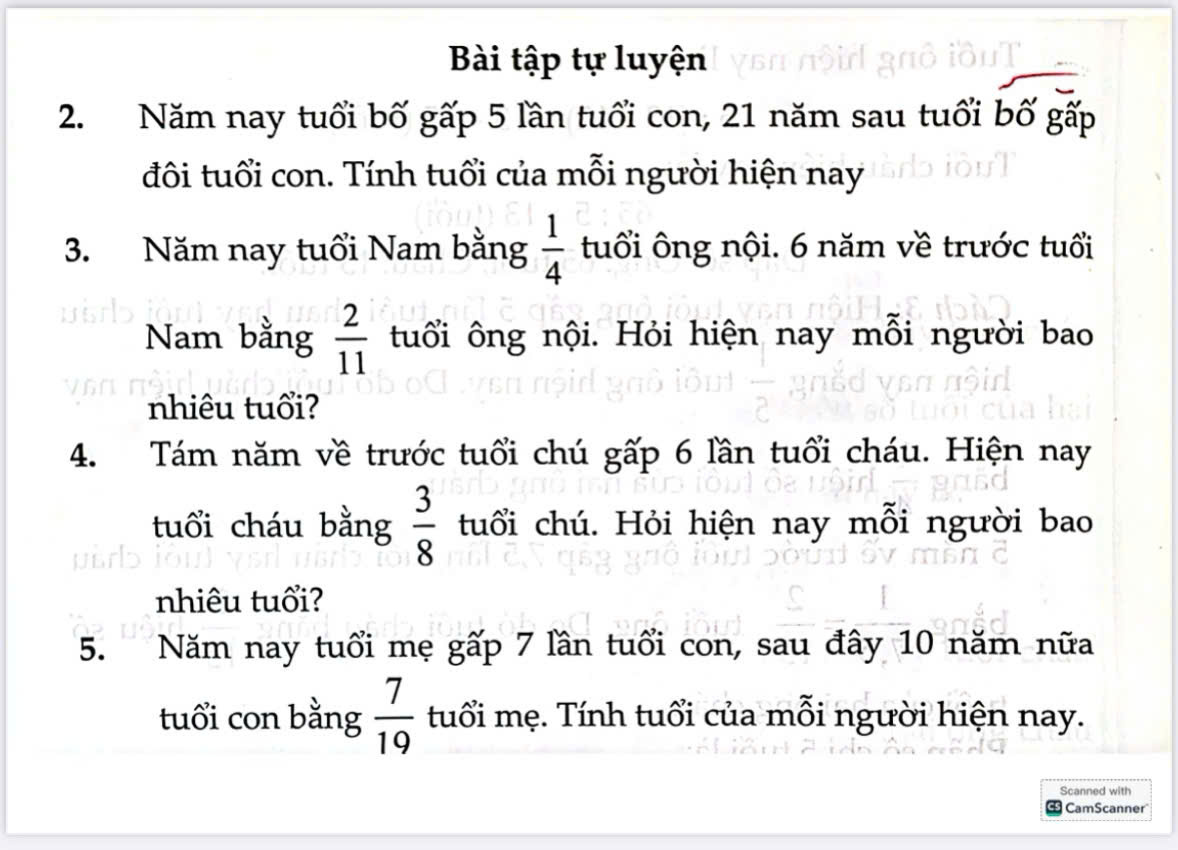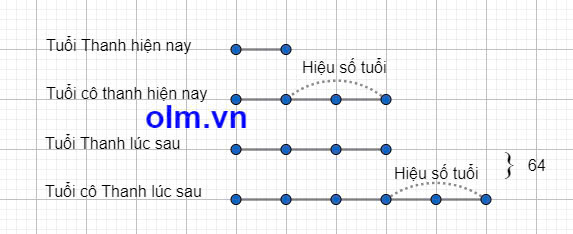tốt
Hãy nhập câu hỏi của bạn vào đây, nếu là tài khoản VIP, bạn sẽ được ưu tiên trả lời.


Giải:
1 phút = 60 giây
Cứ mỗi phút con ốc sên bò được số mét là:
\(\frac{1}{60}\) x 60 = 1 (m)
Con ốc sên bò quãng đường 4m trong thời gian là:
4 : 1 = 4(phút)
Đáp số: 4 phút

Đổi 5h 24 phút = 27/5 giờ
Gọi độ dài quãng đường AB là x (km) với x>0
Thời gian xe đi từ A đến B là: \(\dfrac{x}{50}\) giờ
Thời gian xe đi từ B về A là: \(\dfrac{x}{40}\) giờ
Tổng thời gian cả đi và về là: \(\dfrac{x}{50}+\dfrac{x}{40}=\dfrac{9x}{200}\) giờ
Do cả đi và về mất 27/5 giờ nên ta có pt:
\(\dfrac{9x}{200}=\dfrac{27}{5}\)
\(\Leftrightarrow x=120\left(km\right)\)

Olm chào em đây là toán nâng cao chuyên đề bài toán về tính tuổi, cấu trúc thi chuyên, thi học sinh giỏi các cấp. Hôm nay, Olm sẽ hướng dẫn các em giải dạng này bằng phương pháp toán hai tỉ số trong đó có một đại lượng không đổi.
Giải:
Vì mỗi năm mỗi người thêm một tuổi nên hiệu số tuổi hai mẹ con luôn không đổi theo thời gian.
Hiện nay tuổi con là:
1 :(4 - 1) = \(\frac13\) (hiệu số tuổi hai mẹ con)
6,4 = \(\frac{32}{5}\)
Tuổi con bốn năm trước là:
5:(32 - 5) = \(\frac{5}{27}\) (hiệu số tuổi hai mẹ con)
4 tuổi ứng với phân số là:
\(\frac13-\frac{5}{27}\) = \(\frac{4}{27}\) (hiệu số tuổi hai mẹ con)
Hiệu số tuổi hai mẹ con là:
4 : \(\frac{4}{27}\) = 27 (tuổi)
Vậy mẹ sinh con năm mẹ 27 tuổi
Đáp số: 27 tuổi

\(2-\dfrac{1}{13}=\dfrac{26}{13}-\dfrac{1}{13}=\dfrac{25}{13}\)

Câu 2: Năm nay tuổi bố gấp 5 lần tuổi con
=>Tuổi bố=5 lần tuổi con
21 năm sau, tuổi bố gấp đôi tuổi con
=>tuổi bố+21=2(tuổi con+21)
=>5 lần tuổi con+21=2 lần tuổi con+42
=>3 lần tuổi con là 42-21=21
Tuổi con hiện nay là 21:3=7(tuổi)
Tuổi bố hiện nay là 7x5=35(tuổi)
Câu 3: Năm nay, tuổi Nam bằng 1/4 tuổi ông nội
=>Tuổi ông=4 lần tuổi Nam
6 năm trước, tuổi Nam bằng 2/11 lần tuổi của ông Nội
=>tuổi Nam-6=2/11(tuổi ông-6)
=>tuổi Nam-6=2/11(4 lần tuổi Nam-6)
=>tuổi Nam-6=8/11 tuổi Nam-12/11
=>3/11 tuổi Nam là \(6-\dfrac{12}{11}=\dfrac{66}{11}-\dfrac{12}{11}=\dfrac{54}{11}\)
Tuổi Nam hiện nay là \(\dfrac{54}{11}:\dfrac{3}{11}=18\left(tuổi\right)\)
Tuổi ông hiện nay là 18x4=72(tuổi)
Câu 4: 8 năm về trước, tuổi chú gấp 6 lần tuổi cháu
=>Tuổi chú -8=6 x (tuổi cháu-8)
=>tuổi chú -8=6x(3/8 tuổi chú-8)
=>tuổi chú-8=9/4 lần tuổi chú-48
=>5/4 lần tuổi chú là 48-8=40
Tuổi chú là \(40:\dfrac{5}{4}=40\times\dfrac{4}{5}=32\left(tuổi\right)\)
Tuổi cháu hiện nay là \(32\times\dfrac{3}{8}=12\left(tuổi\right)\)
Câu 5:
Sau đây 10 năm thì tuổi con bằng 7/19 tuổi mẹ
=>Tuổi con+10 =7/19(tuổi mẹ+10)
=>Tuổi con+10=7/19(7x tuổi con+10)
=>Tuổi con+10=49/19 lần tuổi con+70/19
=>19 lần tuổi con+190=49 lần tuổi con+70
=>30 lần tuổi con là 190-70=120
Tuổi con hiện nay là 120:30=4(tuổi)
Tuổi mẹ hiện nay là 7x4=28(tuổi)
Bài 2:
Giải:
Vì mỗi năm mỗi người thêm một tuổi nên hiệu số tuổi hai bố con không đổi theo thời gian.
Tuổi con hiện nay là:
1 : (5 - 1) = \(\frac14\) (tuổi hai bố con)
Tuổi con hai mươi mốt năm sau là:
1 :(2 - 1) = \(\frac11\) (hiệu số tuổi hai bố con)
21 tuổi ứng với phân số là:
\(\frac11-\frac14=\frac34\) (hiệu số tuổi hai bố con)
Hiệu số tuổi hai bố con là:
21 : \(\frac34=28\) (tuổi)
Tuổi con hiện nay là:
28 x \(\frac14=7\) (tuổi)
Tuổi bố hiện nay là: 7 + 28 = 35(tuổi)
Đáp số: tuổi bố hiện nay là 35 tuổi, tuổi con hiện nay là 7 tuổi

Câu 15:
Đây là toán nâng cao chuyên đề bài toán tính tuổi, cấu trúc thi chuyên, thi học sinh giỏi các cấp. Hôm nay, Olm sẽ hướng dẫn các em giải chi tiết dạng này bằng sơ đồ đoạn thẳng như sau:
Giải:
Hiệu số tuổi hai cô cháu bằng: (3 - 1): 1 = \(\frac21\) (tuổi Linh hiện nay)
Coi tuổi Linh hiện nay là 1 phần
ta có sơ đồ:
Theo sơ đồ ta có:
Tuổi Linh hiện nay là: 64:(3 + 2 + 3) = 8 (tuổi)
Tuổi cô Thanh hiện nay là: 8 : \(\frac13\) = 24(tuổi)
Đáp số:
Tuổi Linh hiện nay là: 8 tuổi.
Tuổi cô Thanh hiện nay là 24 tuổi

Thời gian Như làm mỗi con hạc giấy là:
\(20,4:4=5,1\) (phút) = 5 phút 6 giây
Đáp số: 5 phút 6 giây

Giải:
Số có hai chữ số có dạng: \(\overline{ab}\)
Viết thêm chữ số 0 vào giữa hai chữ số của số đó ta được số mới là: \(\overline{a0b}\)
Theo bài ra ta có:
\(\overline{a0b}\) = 6 x \(\overline{ab}\)
100a + b = 60a + b
100a + b - 60a - 6b = 0
(100a - 60a) - (6b - b) = 0
40a - 5b = 0
8a - b = 0
8a = b
b ≤ 9 ⇒ 8a ≤ 9 ⇒ a ≤ 9 : 8 ⇒ a < 2 ⇒ a = 0; 1
Vì a không thể bằng không nên a = 1, b = 8a = 8.1 = 8
Vậy số cần tìm là 18




Olm chào em, cảm ơn đánh giá của em về chất lượng bài giảng của Olm, cảm ơn em đã đồng hành cùng Olm trên hành trình tri thức. Chúc em học tập hiệu quả và vui vẻ cùng Olm em nhé!
hsyeuwueryu23682938553346475--++-45666-*53+456